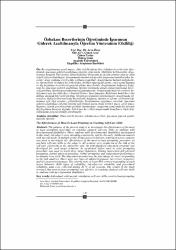Özbakım Becerilerinin Öğretiminde İpucunun Giderek Azaltılmasıyla Öğretim Yönetiminin Etkililiği
Abstract
Bu araştırmanın genel amacı, zihin özürlü öğrencilere özbakım becerilerinin öğretiminde ipucunun giderek azaltılması öğretim yönteminin etkililiğini belirlemektir. Araştırmaya Anadolu Üniversitesi Zihin Engelliler Programı'na devam etmekte olan üç zihin özürlü öğrenci katılmıştır. Araştırmanın modeli tek-denekli araştırma modellerinden beceriler arası yoklama evreli çoklu yoklama modelidir. Araştırmanın bağımlı değişkenleri, öğrencilerin öz-bakım becerilerinden, bisiklet yaka kazak giyme, çıtçıt açma-kapama ve diş fırçalama becerilerini gerçekleştirme düzeyleridir. Araştırmanın bağımsız değişkeni ise, ipucunun giderek azaltılması öğretim yöntemine dayalı olarak hazırlanan bireyselleştirilmiş öğretim programlarının uygulanmasıdır. Araştırmada hedef becerilerin belirlenmesi için öncelikle beceri kontrol listeleri hazırlanmıştır. Belirlenen hedef beceriler dikkate alınarak bireyselleştirilmiş öğretim programları hazırlanmıştır. Araştırmada öğrencilere ilişkin belirlenen hedef becerilerde, başlama, öğretim ve izleme verilerinin toplanması için ölçü araçları geliştirilmiştir. Araştırmanın uygulama evresinde ipucunun giderek azaltılması öğretim yöntemi tam fiziksel ipucu, kısmi fiziksel ipucu, sözel ipucu, bağımsız olarak gerçekleştirme şeklinde sunulmuştur. Araştırma sonucunda bir deneğin diş fırçalama becerisi dışında, belirlenen becerileri araştırmada hedeflenen ölçüt doğrultusunda gerçekleştirdiği görülmüştür. The purpose of the present study is to investigate the effectiveness of the most to least prompting procedure on teaching chained self-care skills to students with developmental disabilities. Three students with developmental disabilities participated in this study. All subjects were attending a university unit for the early childhood students with special needs. A multiple probe design across behaviors, replicated across students was used to investigate the effectiveness of the most-to-least prompting procedure on teaching self-care skills to the subjects. All sessions were conducted at the sink of the self-care classroom at the university unit. An Individualized education program was developed for each target behavior. As mentioned before most to least prompting procedure was used to teach these target behaviors. During instruction full physical prompting, partial physical promting, verbal prompting and independent performance techniques were used. The dependent measure was the percentage of correct responding to the task analyses. There were two types of subject responses: (a) correct responses, and (b) incorrect responses. The criteria were at least 80% correct responding of each target behavior. Both types of reliability, interobserver reliability and procedural reliability, data were collected during 20 % of all sessions. The results of the study revealed that most-to-least prompting was effective in teaching chained self-care skills to students with developmental disabilities.
Source
Anadolu Üniversitesi Sosyal Bilimler DergisiVolume
2Issue
2URI
http://www.trdizin.gov.tr/publication/paper/detail/TVRReE9Uaz0=https://hdl.handle.net/11421/15569


















